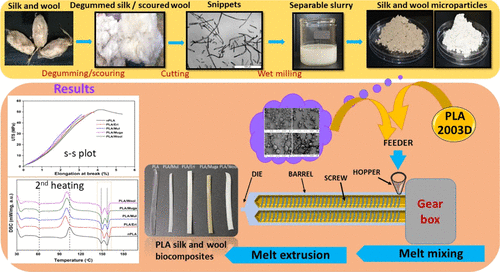当前位置:
X-MOL 学术
›
ACS Appl. Polym. Mater.
›
论文详情
Our official English website, www.x-mol.net, welcomes your
feedback! (Note: you will need to create a separate account there.)
Silk and Wool Protein Microparticle-Reinforced Crystalline Polylactic Acid Biocomposites with Improved Cell Interaction for Targeted Biomedical Applications
ACS Applied Polymer Materials ( IF 4.4 ) Pub Date : 2020-09-24 , DOI: 10.1021/acsapm.0c00673 Purabi Bhagabati 1 , Siddharth Mohan Bhasney 1 , Devleena Bose 1 , Rechana Remadevi 2 , Mohan Setty 2 , Rangam Rajkhowa 2 , Vimal Katiyar 1
ACS Applied Polymer Materials ( IF 4.4 ) Pub Date : 2020-09-24 , DOI: 10.1021/acsapm.0c00673 Purabi Bhagabati 1 , Siddharth Mohan Bhasney 1 , Devleena Bose 1 , Rechana Remadevi 2 , Mohan Setty 2 , Rangam Rajkhowa 2 , Vimal Katiyar 1
Affiliation

|
Silk fibroin and wool keratin are easily available biocompatible structural protein fibers with cell adhesion properties. Bottom-up approaches to convert silk and wool fibers to biomaterials of different forms require harsh chemicals and result in materials with poor mechanical properties. In this work, microparticles were prepared from wool and three types of silk fibers by a top-down approach, which is scalable and requires less processing as compared to other bottom up approaches. The fabricated microparticles (5 wt %) were added during melt extrusion of poly(lactic acid) [PLA] to create hybrid biocomposites. Thermal stability of these protein particles in retaining the native structure present in fibers, particularly in silk varieties containing poly-alanine [poly(Ala)] domains, allowed their inclusion in melt-based processing without thermal degradation. The influence of protein microparticles of different amino acid compositions of silk and wool on molecular weight, crystal growth, microstructure, and mechanical, thermal, hydrophilic, and cell compatibility of PLA was investigated. Crystal density of PLA was increased up to 4.5 times and % crystallinity was increased up to 2 times on the addition of the particle fillers. Silk-containing amino acid repeats of poly(Ala) domains were found to be more effective fillers and had good interfacial adhesion with PLA, while the interaction between PLA and wool was poor. Silk fillers produced more hydrophilic biocomposites and supported higher activity of UMR 106 cells in comparison to neat PLA. PLA is gaining increasing attention from the research community and the biomedical industries as a potential alternate to metal implants in bone fixation devices. The study demonstrates that silk particles, particularly those with a poly(Ala) sequence, amplify the acceptability of PLA biocomposites as advanced biodegradable composites for targeted biomedical applications such as bone-fixation devices.
中文翻译:

丝绸和羊毛蛋白微粒增强的结晶聚乳酸生物复合材料,具有针对性生物医学应用的改善的细胞相互作用
丝素蛋白和羊毛角蛋白是容易获得的具有细胞粘附特性的生物相容性结构蛋白纤维。自下而上的将丝绸和羊毛纤维转变为不同形式的生物材料的方法需要苛刻的化学药品,导致材料的机械性能较差。在这项工作中,通过自上而下的方法由羊毛和三种类型的丝纤维制备了微粒,与其他自下而上的方法相比,这种方法可扩展并且需要更少的处理。在聚(乳酸)[PLA]的熔融挤出过程中添加制造的微粒(5重量%)以产生杂化生物复合材料。这些蛋白质颗粒的热稳定性可保留纤维中的天然结构,特别是在含有聚丙氨酸[poly(Ala)]域的蚕丝品种中,允许它们包含在基于熔体的加工中而不会发生热降解。研究了丝绸和羊毛的不同氨基酸组成的蛋白质微粒对PLA的分子量,晶体生长,微观结构以及机械,热,亲水和细胞相容性的影响。添加颗粒填料后,PLA的晶体密度增加到4.5倍,结晶度%增加到2倍。发现聚(Ala)结构域的含丝氨基酸重复序列是更有效的填充剂,与PLA的界面粘合性好,而PLA与羊毛之间的相互作用差。与纯净的PLA相比,丝绸填充剂可产生更多的亲水性生物复合材料,并支持较高的UMR 106细胞活性。作为骨固定装置中金属植入物的潜在替代品,PLA正受到研究界和生物医学行业的越来越多的关注。这项研究表明,丝绸颗粒,特别是具有聚(Ala)序列的丝绸颗粒,可以扩大PLA生物复合材料作为先进的可生物降解复合材料的接受度,从而可用于有针对性的生物医学应用,例如骨固定装置。
更新日期:2020-11-13
中文翻译:

丝绸和羊毛蛋白微粒增强的结晶聚乳酸生物复合材料,具有针对性生物医学应用的改善的细胞相互作用
丝素蛋白和羊毛角蛋白是容易获得的具有细胞粘附特性的生物相容性结构蛋白纤维。自下而上的将丝绸和羊毛纤维转变为不同形式的生物材料的方法需要苛刻的化学药品,导致材料的机械性能较差。在这项工作中,通过自上而下的方法由羊毛和三种类型的丝纤维制备了微粒,与其他自下而上的方法相比,这种方法可扩展并且需要更少的处理。在聚(乳酸)[PLA]的熔融挤出过程中添加制造的微粒(5重量%)以产生杂化生物复合材料。这些蛋白质颗粒的热稳定性可保留纤维中的天然结构,特别是在含有聚丙氨酸[poly(Ala)]域的蚕丝品种中,允许它们包含在基于熔体的加工中而不会发生热降解。研究了丝绸和羊毛的不同氨基酸组成的蛋白质微粒对PLA的分子量,晶体生长,微观结构以及机械,热,亲水和细胞相容性的影响。添加颗粒填料后,PLA的晶体密度增加到4.5倍,结晶度%增加到2倍。发现聚(Ala)结构域的含丝氨基酸重复序列是更有效的填充剂,与PLA的界面粘合性好,而PLA与羊毛之间的相互作用差。与纯净的PLA相比,丝绸填充剂可产生更多的亲水性生物复合材料,并支持较高的UMR 106细胞活性。作为骨固定装置中金属植入物的潜在替代品,PLA正受到研究界和生物医学行业的越来越多的关注。这项研究表明,丝绸颗粒,特别是具有聚(Ala)序列的丝绸颗粒,可以扩大PLA生物复合材料作为先进的可生物降解复合材料的接受度,从而可用于有针对性的生物医学应用,例如骨固定装置。











































 京公网安备 11010802027423号
京公网安备 11010802027423号